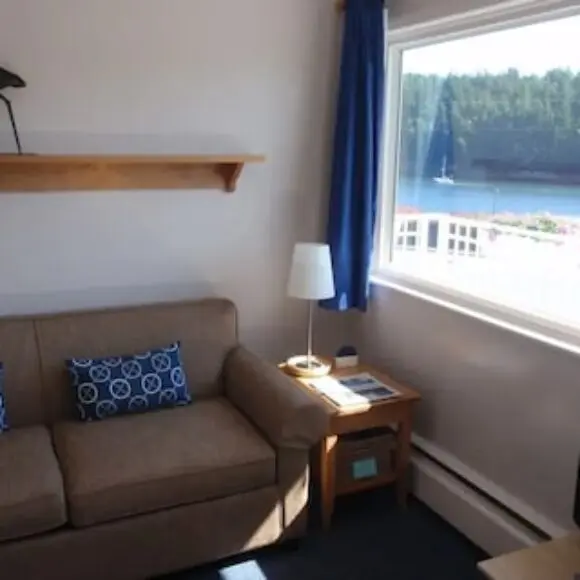Hotel Buccaneer Inn

Buccaneer Inn
Hotel Buccaneer Inn reviews
Planning your ferry trip from Nanaimo? Stay at Buccaneer Inn; rated and is available from CAD $ 108. Buccaneer Inn is perfectly situated near the ferry routes, and can be reserved directly through Trivago.
📍 Address Buccaneer Inn
1577 Stewart Avenue, V9S 4E3, Nanaimo, Canada
FAQ
What are the vehicle height restrictions for the ferry Vancouver sailing from Texada Island (Blubber Bay) to Powell River (Little River)?
Vehicle height restrictions are in place for the ferry Vancouver sailing from Texada Island (Blubber Bay) to Powell River (Little River) to ensure the safe loading and transport of vehicles. To avoid any issues, it’s crucial to review the Blubber Bay to Powell River vehicle restrictions page. This resource provides detailed information on maximum vehicle heights and any other relevant restrictions.
What is the travel time for the ferry Vancouver route from Nanaimo (Departure Bay) to Horseshoe Bay?
The travel time for the ferry Vancouver route from Nanaimo (Departure Bay) to Horseshoe Bay is approximately one hour and forty minutes. However, it’s always best to verify the exact duration by checking the Nanaimo to Horseshoe Bay crossing times. This crossing time can be affected by weather conditions and other unforeseen circumstances.
Ferry Vancouver
Multi-day Vancouver Island itineraries often begin with ferry travel from the mainland, allowing tourists to explore the island’s diverse regions. Popular destinations include Victoria’s Inner Harbour, Tofino’s surf beaches, and the wine regions of the Cowichan Valley. Ferry connections enable comprehensive island exploration combining urban and wilderness experiences.
Real-time information about ferry schedules, delays, and availability helps travelers plan their Vancouver Island journey effectively. Mobile apps and online resources provide current sailing information and terminal conditions. Staying informed prevents delays and ensures smooth travel experiences.
Emergency procedures and safety protocols ensure passenger security throughout ferry crossings. Modern vessels feature comprehensive safety equipment and trained crew members. Regular safety drills and equipment inspections maintain the highest safety standards for all passengers and vehicles.
Ferry travel tips for first-time visitors include arriving early, bringing layers for changing weather conditions, and planning ground transportation in advance. Understanding terminal layouts and boarding procedures reduces travel stress. Experienced ferry travelers recommend booking accommodations on Vancouver Island in advance, especially during peak season periods.
Horseshoe Bay to Departure Bay offers another major ferry route connecting West Vancouver to Nanaimo on Vancouver Island’s east coast. This scenic 100-minute crossing provides spectacular views of Howe Sound and the Coast Mountains. Nanaimo serves as an excellent gateway to explore central Vancouver Island, including access to Tofino, Cathedral Grove, and numerous outdoor recreation areas.
Food and dining onboard ranges from casual cafeterias to full-service restaurants depending on the vessel and route. Local British Columbia ingredients feature prominently in menu offerings. Passengers can also bring their own food and enjoy meals in designated dining areas or outdoor spaces.
Cargo and freight services operate alongside passenger ferries, supporting Vancouver Island’s economy and supply chains. Commercial vehicles transport everything from fresh produce to building materials. This integrated transportation system maintains Vancouver Island’s connection to mainland markets and services.
Wildlife viewing opportunities during ferry crossings include orcas, seals, dolphins, and diverse seabird species throughout the Salish Sea. The best viewing occurs from outdoor decks, and crew members often announce wildlife sightings over the ship’s public address system. Binoculars enhance the wildlife watching experience during these scenic journeys.
Vehicle transport options accommodate everything from motorcycles to large RVs and commercial trucks. Different vehicle categories have specific size restrictions and pricing structures. Passengers traveling with vehicles should arrive early for check-in and security screening processes at ferry terminals.
Vancouver Island ferry terminals feature modern amenities including restaurants, gift shops, and comfortable waiting areas. Tsawwassen and Swartz Bay terminals offer extensive facilities with multiple dining options, retail stores, and children’s play areas. Terminal locations provide convenient access to ground transportation, rental cars, and connecting bus services.
Accessibility features ensure all passengers can enjoy ferry travel, with elevators, wheelchair-accessible restrooms, and designated seating areas. Vehicles with accessibility equipment receive priority boarding assistance. Ferry staff provide support for passengers with mobility challenges throughout the journey.




